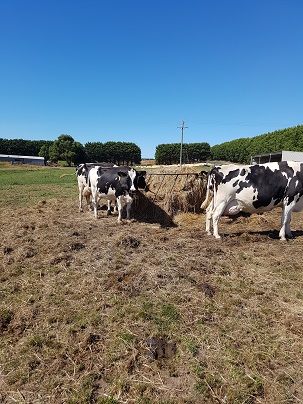The Weakest Link Dry Cow Nutrition

It has been said often; if we get transition right we’ve likely achieved the highest goal to profitable dairying. Last month I gave our definition of transition period: from dry off to conception. The jobs not done till she’s in-calf! Uptake of the management information available for springing cows and early lactation has been slow, but gaining momentum. Without doubt, dry cow nutrition is now our greatest legacy.
Rumination data generated from devices on dry cows during summer months on one of my best performing client’s farms was ‘shock therapy’ to him. And this was only highlighting dry matter intake. Rumination data tells nothing of nutrient intake. Turning out dry cows to back paddocks or out-blocks with no dietary supervision will negate the best springer cow management.
Dry Matter intake is obviously the first consideration. The risk of low intake, and hence low energy and protein, during drier months is very high. Conversely, the risk of excessive intake, particularly excessive energy intake in abundant pasture, is equally as damaging to the cow entering the springing group for lead feeding. The first will have lost weight, mobilising body fat to meet her energy needs, the second will have gained weight and will certainly have low intake post-calving. Either scenario will induce fatty liver syndrome/ketosis post-calving.
We have verified both these scenarios through blood testing cows as they enter the springer group (post-dry period) and soon after calving. Both showed high BHBA readings, the indicator of sub-clinical ketosis from excessive fat metabolism.
The Summer Dry Cow. Pasture hay or cereal hay will rarely meet the dry cow’s energy needs. She will need an energy supplement in the form of grain. Pasture silage generally will be higher in energy than hay and will meet her energy needs. Adlib intakes of either hay or silage make for easy management. If grain with mineral inclusion is fed (dairy grain), then minerals should be adequate assuming the dairy grain is adequate in mineral inclusion. Where just silage or hay is fed, dry cows must have mineral supplementation. We manufacture a self-feed/controlled intake loose-lick mineral product, high in calcium, for this purpose. Again, making dry cow adlib feed management an easy task, but meeting all her needs.
The Grazing Season Dry Cow. Dry cows with access to unlimited pasture will gain weight and predispose themselves to ketosis post-calving. Don’t underestimate this risk of sub-clinical ketosis as too often the condition passes unnoticed unless the cow is tested. There are milk keto test strips available for doing this. A combination of the energy density of pasture and the cow’s capacity to consume large quantities invariable exposes her to weight gain and suppressed feed intake post-calving, and the ketosis risk again. Do not rely on BCS scoring to tell you if these risks are occurring. By the time you can see a change in body score, I assure you, she is well on her way to ketosis.
Only blood tests will pick this up well before the risk factor has become disease. Blood testing of dry cows has also highlighted negative energy balance and weight loss when it was assumed there was ample pasture available. We always have adlib silage or hay on offer to dry cows even with ‘heaps of pasture’ available! I also defy anybody who can accurately tell me grazed pasture intake from eye or electronic assessment of pasture stands.
Unmanaged grazing will encourage selective grazing. This results in dry cows consuming highly digestible regrowth, high in energy and crude protein, but very low in fibre. The end result is acidotic dry cows. Back to the stress factors in last month’s article. Dry cows need a high fibre diet for good rumination and repair of rumen wall damage from sub-optimal rumen pH bouts during lactation. Yes it’s a tension, like everything else in life, but it’s also management, and nothing impacts profit (milk price excluded) like good cow and feed management.
The second issue in dry cow nutrition revolves around immunity, which is not unrelated to nutrition. A high fibre diet with adequate energy and protein will promote a strong immune system. Alternately, inadequate energy/protein intake will induce mobilisation of body fat to support maintenance and pregnancy and is the first step to depriving the immune system of its nutritional needs.
A dry cow diet inadequate in fibre will promote reduced rumen pH from low rumination/saliva production and nutritional deficiencies due to undigested feed passing out in manure. However, sub-clinical acidosis is a stress factor that will disable immunity’s full capacity to deal with any bacterial or pathogen assault.
Dry Cow Therapy in conjunction with your veterinarian, be it just Dry Cow Treatment and/or Teat Seal is certainly an investment in both post-calving milk production and fertility. The number of heifers reported to me as having mastitis at calving is alarming and several clients are now Teat Sealing heifers prior to calving. Consult your veterinarian on this. Summer flies and winter mud; the risk is ever there.
Mastitis between calving and joining can reduce fertility by 30%. Mastitis between joining and six weeks post-joining can cause up to 60% loss of foetuses. Cell counts above 200,000 are considered sub-clinical infections and recommended to be treated.
According to a Dairy Cattle Reproduction Council webinar a couple of years ago, milk production, age and BCS only explain a small amount of non-cycling cows. It was stated clearly, cow health makes a substantial difference on cow cyclicity. Cows suffering sub-clinical disease, either metabolic (milk fever/ketosis), or infectious (metritis, respiratory disease, but especially mastitis) exhibit the lowest level of cyclicity.
I shudder every time I hear the comment: “it’ll be good dry cow feed”! No other management factor is going to affect our dairy profit this year like dry cow management; yet, they frequently are the most neglected group of stock on farm. Many successful lactations and fertility are written-off during the dry cow period.